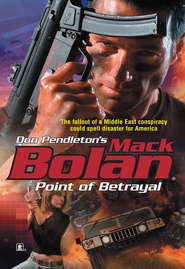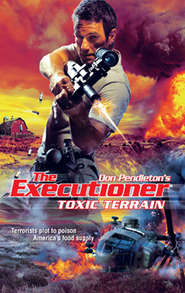По всем вопросам обращайтесь на: info@litportal.ru
(©) 2003-2025.
✖
Triplecross
Автор
Год написания книги
2019
Настройки чтения
Размер шрифта
Высота строк
Поля
“Get used to it, boys,” McCarter warned, “because my bet is that it’s going to get worse before we’re done here.”
CHAPTER TWO
Stony Man Farm, Virginia
Aaron “the Bear” Kurtzman sat huddled with a “tactical battle mug” of his industrial-strength coffee. The milled aluminum mug, which Barbara Price had called a “flagon,” had been a gift from a special operations team with whom the Farm had partnered some time back. The funny thing about the mug was that it bore a set of milled rails, identical to those on an M-4 carbine. The men of Able Team and Phoenix Force had, off and on, teased the cybernetics genius about the best optics to mount on his coffee cup.
Kurtzman, for his part, was unruffled by their good-natured ribbing. He had been the head of the cybernetics team at the Farm since the Special Operations Group had first set up shop in the mountains of Virginia. He had not, however, always been in a wheelchair. That was the result of an attack on the Farm, one that had taken a heavy toll on the men and women of the SOG. Kurtzman, for his part, had simply gone on doing his job. He did not discuss his disability and had never once complained about it to anyone, as far as Barbara Price knew.
Price, for her part, looked through her briefing folder. The Farm’s honey-blonde, model-beautiful mission controller checked the array of switches set within the briefing room’s conference table. The flat-screen monitor at the far end of the room was already up and running. A scrambled satellite link between Washington and the Farm showed Hal Brognola’s desk in his office on the Potomac in Wonderland. The big Fed was not himself at the desk, but he would be. He had excused himself briefly to speak with some government functionary or other in the hallway. When he was done he would secure the door to his office—on which was printed, simply, Hal Brognola: Justice—and rejoin them for the briefing.
On a second monitor, this one opposite one side of the conference table, the men of Phoenix Force were assembling in front of their own portable satellite uplink. Wherever they were, it looked cold through the rear viewport of the MRAP crew compartment. David McCarter, leader of Phoenix Force, was peering into the uplink camera, looking annoyed. Calvin James and T. J. Hawkins sat to either side of him.
Encizo and Manning were not visible on screen. They were, no doubt, guarding Phoenix Force’s position in hostile territory, probably from the turrets of the armored vehicles. Price did not like to think of the five-man team operating largely without support across so much open ground, but that was the job that Phoenix Force did. She loved every one of the men on that team like older brothers.
A disturbance in the corridor outside the briefing room indicated that Able Team was on its way. It was Hermann “Gadgets” Schwarz who entered first. As was often the case, he was locked in some sort of deeply philosophical argument with Rosario Blancanales, his teammate. Blancanales was known as “Pol,” short for “the Politician.” The soft-spoken, gray-haired Hispanic was, in fact, a former Black Beret, not to mention an expert in the psychology of violence and the application of role camouflage. Schwarz was, as his nickname “Gadgets” implied, Able Team’s electronics expert. His work had contributed to quite a bit of the equipment fielded by both Able and Phoenix, including the earbud transceivers that kept the teammates in constant voice contact while on missions.
Behind Blancanales and Schwarz, his huge fist wrapped around a foam cup of black coffee, was Carl “Ironman” Lyons, leader of Able Team. The big, former LAPD officer dwarfed his teammates simply through bulk. He was powerfully built and moved with all the subtlety of a bulldozer.
“I’m telling you,” Schwarz said to Blancanales, “every adventure movie where the hero gets caught and then has to fight his way out is automatically cliché. A bad guy catches a good guy, what’s he going to do? He’s going to kill him or he’s going to torture him, but either way our hero isn’t going to get free.”
“But real people have escaped terrorist captors and home invaders in real life,” Blancanales countered. “People who didn’t even have any training. In your movie the hero is always a tough guy or someone who’s ex-military. Or both.”
“Exactly my point,” Schwarz said.
“Gadgets, do you realize you say, ‘Exactly my point,’ every time you start to lose an argument?”
“Exactly my point,” Schwarz repeated.
“So a trained, albeit fictional military or law-enforcement hero can’t do what a real-life civilian can do.”
“Exactly my—”
“Here,” Blancanales said. From his pocket he took a red-dot sight. “I can’t get this to illuminate. I changed the battery and everything. I think it’s broken. Why don’t you uphold that science-whiz reputation you have and see if you can’t fix it?”
“Isn’t this Cowboy’s department?”
“Cowboy and the armory are backed up,” Blancanales said. “I know you can help.”
“Did this come off Aaron’s coffee cup?” Schwarz said, grinning.
“Don’t start,” Kurtzman grumbled. “My revenge will be swift and terrible.”
“Why’s the hero getting caught in the first place?” Lyons put in. That surprised Price, who usually thought of him as the straight man for Schwarz’s banter. Obviously, Lyons and Blancanales were a bit taken aback, as well; they both turned and eyed Lyons curiously before Schwarz managed a response.
“Well, we’ve all been...” Schwarz looked sheepish.
“What?” Lyons demanded. “Caught by the enemy?”
“You’ve got to admit that the sheer number of times that—” Blancanales began.
“If we’re all ready to start?” interrupted Hal Brognola.
The assembled Stony Man operatives turned to regard the larger-than-life satellite image of Hal Brognola. The head of the Sensitive Operations Group was chewing an unlighted cigar and looked as harried as he always did.
Not for the first time or the hundredth time, Price worried about the amount of stress the man was under. A lot of world power plays fell under Brognola’s watch. Still more of those turned into fires that the SOG was tasked to put out.
Such as the one they were about to talk about.
“You are go, Hal,” said Price. “Phoenix is live and connected.”
“Ready and waiting,” McCarter acknowledged. “We can’t sit here for too much longer, though. Our hind ends are hanging in the wind.”
“Understood,” Brognola noted. He cleared his throat. “To put it bluntly, a series of military skirmishes between what seems to be Pakistani and Indian forces are driving our intelligence assets batty. Neither government admits to deploying military assets in the region.”
“And that region is?” Lyons asked.
“In an around the disputed territory of Kashmir,” Brognola explained. “As you know, due to a rather complicated series of political maneuvers more than half a century ago, the two nations have, arguably, been in a state of low-grade war ever since. They simply do not like each other. Over the years the conflict has flared up and then died down. It’s gone on like that, hot and cold, for decades. Recently, a ceasefire was brokered by the Man and several high-profile diplomats with plenty of political capital in the United Nations. It was a big deal.”
“I remember seeing that on the news,” Schwarz said.
“What makes any lessening of tensions between Pakistan and India so important,” Brognola continued, “is the fact that the two nations are among the eight nations of the world who have, or who are believed to have, viable nuclear weapons. The United States, Russia, the United Kingdom, France and China you know. Israel has long been suspected by the rest of the world to possess defensive nukes of its own, and while they won’t admit it, we wouldn’t be SOG if we didn’t know that, yes, they do. North Korea, for all its problems, has been a nuclear power since 2006.”
“If their tests aren’t hoaxes,” McCarter said. “This is a nation that builds ghost cities on its borders to make the South believe it’s not mired in poverty.”
“Nonetheless,” Brognola said, “the relatively short list underscores just how dangerous it is to have India and Pakistan rattling sabers at each other. The conflict destabilizes the entire region, but if it goes too far...”
“One of the two is going to start thinking they don’t want to wait any longer to see what their nukes can do,” Lyons finished.
“India tested their Pokhran-1, code-named ‘Smiling Buddha,’ back in ’74,” Price said. “Pakistan went nuclear later, but they’re not new to the game. They conducted a string of underground nuclear tests in ’98, as retaliation for India’s Pokhran-2, or Operation Shakti. The message on the part of both nations was clear—we’ve got the means to wipe you out. Either because of that threat or despite it, the two have skirmished with each other but never gone all the way. The President is concerned that if things keep going as they are, all-out war is assured...and we think we know why.”
“Neither India nor Pakistan will take credit for voluntarily committing forces to the border conflict,” Brognola said. “Both countries claim their own patrols have come under unprovoked attack. As you can imagine, any one of these attacks can be construed as an act of war. Our thermal imaging has mapped out a series of border conflicts between what we at first believed were elements of the Pakistani and Indian armies. We were right...and we were wrong.”
“Okay, I’m officially confused,” Blancanales protested.
“During the mop-up of a clash with what we took to be both Indian and Pakistani uniformed soldiers,” Brognola explained, “Phoenix Force took digital photographs of as many of the dead soldiers as they could. Those photographs have been analyzed at the Farm.”
“We’ve run the identities of the soldiers through our databases,” Kurtzman put in. “Many of them have no file on record. The ones that do, however, have something very specific in common.” He tapped a few buttons on the keyboard built into the conference table. A pair of images came up on the wall screen next to Brognola’s image. The two men depicted were both dark of skin and wearing military uniforms.
“The heavyset man is Ibrahim Jamali of Pakistan. His thinner, hawk-nosed counterpart is India’s Siraj Gera. Both men were or are generals in their respective armies. But there’s more.”
Kurtzman took the cue and tapped several more keys. Now a grid of images appeared. The faces were much alike and too small to be particularly memorable, but the text below each image indicated that the file photo belonged to a man found dead by Phoenix Force.
“The men you see here were all found dead at the scene of a battle in the Kashmir area. During the conflict, both sides targeted Phoenix Force. What all of the men listed here have in common is that they’re dead.”
“Naturally,” said Lyons.
“No, not after the battle,” Kurtzman said. “They were already dead.”











